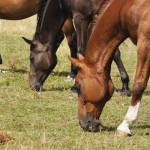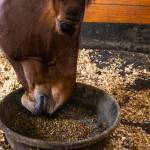Turnout Tips: When’s Best to Graze?

Proper turnout offers innumerable benefits. Turned-out horses are typically more fit due to increased exercise; show less anxiety with fewer stereotypies; have healthier, more robust respiratory systems; maintain strong musculoskeletal systems; and potentially have fewer gastric ulcers due to a longer, more sustained feeding pattern.
Nonetheless, not all horses can be managed 24/7 on pasture, and there are some that should not be allowed to graze willy-nilly for fear of laminitis. If your horse has signs of insulin resistance (IR) or has been diagnosed with either IR or equine metabolic syndrome then timing of turnout needs to be optimized to maximize health and minimize ingestion of fructans.
“Fructans are short chains of a specific sugar molecule called fructose that cannot be broken down in the stomach or small intestine. Instead, they are fermented in the intestine. Large amounts of fructan aren’t tolerated well by some horses and can result in colic and laminitis,” explains Kathleen Crandell, Ph.D., an equine nutritionist at Kentucky Equine Research.
According to Crandell, the level of fructan in forage varies depending on type of grass or legume, time of day, season, and even which part of the plant is being grazed (leaves versus stems). As such, timing of turnout can impact how much fructan is being ingested. Consider these factors when turning out your horse, especially if it is known to either have or be at risk for IR:
1. Fructan concentrations are higher during periods of fast forage growth. Minimize grazing in spring and after heavy rain following a heat wave. Grazing muzzles are often used for this purpose.
2. Fructan levels are higher in the stems than the leaves. Therefore, avoid overgrazing pastures so horses do not consume fructose-laden stems close to the ground. Pasture rotation can help achieve this goal.
3. Stressed plants produce more fructan than happy plants. Drought and poor soil conditions (e.g., high salinity) are examples of stressors; thus, limit grazing when such conditions exist.
4. Fructans are produced in the leaves during photosynthesis in the daytime. In general, allow horses to graze either in the early morning or evening to minimize ingestion of fructose-rich leaves. Be aware that those are peak feeding times for mosquitoes, which can transmit a multitude of infection-causing organisms, including the West Nile virus. Use protection in the form of insect repellants and sheets.
“It is also important to note that starches and sugars, including fructans, aren’t problematic for all horses. In cases of hindgut acidosis, a hindgut buffer such as EquiShure might be useful and pasture analysis can benefit IR horses,” Crandell said.








